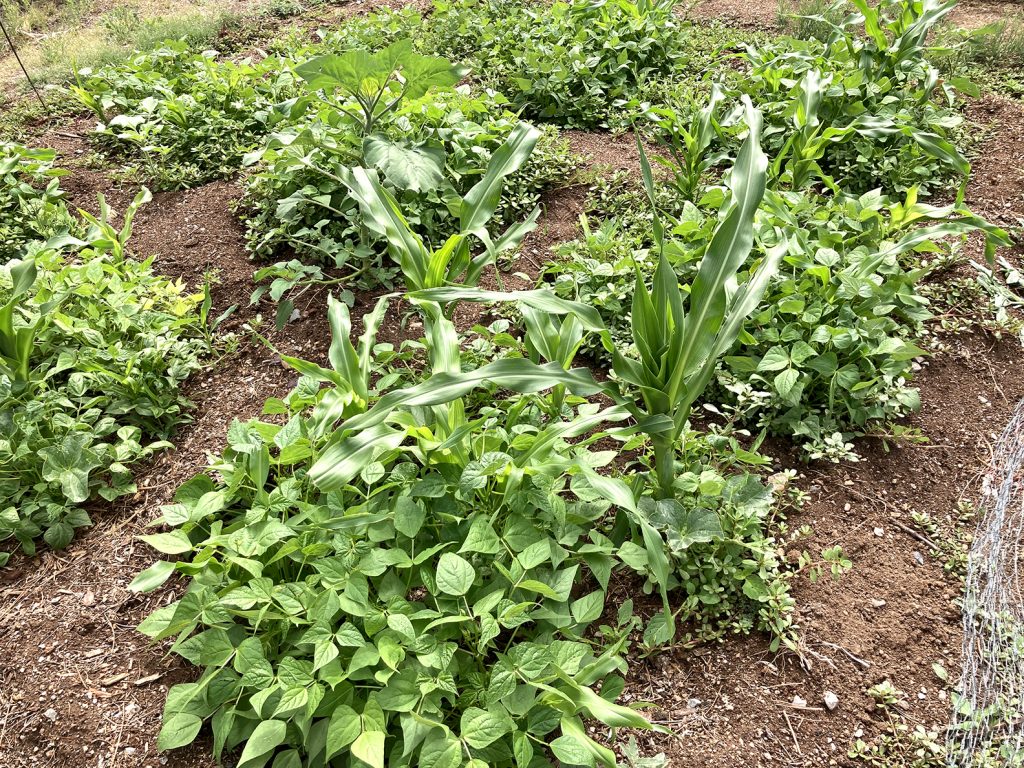Issue 1 – mid Rio Grande Times – March 2021
Collaborators: Sue Brown, Kathy Chilton, Donna Detweiler, Ken Gingerich, Steve Glass, Mike Halverson, Adrienne Jones, Glen Kappy, Shelly Lemon, Deb Scott

Issue 1 – mid Rio Grande Times – March 2021
Collaborators: Sue Brown, Kathy Chilton, Donna Detweiler, Ken Gingerich, Steve Glass, Mike Halverson, Adrienne Jones, Glen Kappy, Shelly Lemon, Deb Scott

A thousand or more years ago, pueblo farmers in the Southwest were incorporating principles of permaculture in their farming techniques. This traditional practice uses berms and swales in a sunken garden. These waffle squares work especially well for deep rooted plants.
Twelve to 18 inch squares are laid out in a pattern which has a berm on all four sides. Since there is so much clay in our environment, the clay pulled up from the center part of the square forms the berm and is easily compacted. The berm can be three or four inches high and wide enough that you can step on it to compact it. The remaining soil in the center of the square will probably need compost.
Here are two diagrams to help you lay out a waffle garden.
Now, put into verse, this warning from a young global activist.
Greta
She says we have stolen our children’s childhoods and their dreams.
Their future projected on smaller screens where there are now
large blank spaces
that once were filled with species which used to color the world.
The world reduced to memories of what we used to love
And enlarged by what we need to learn: how to survive the heat,
how to live without oceans and their coasts,
how to move entire cities to higher ground,
how to grow food without water,
how to breathe without air.
By Mary Dudley, “Civilization in Crisis,” edited White and Wilder
Farther up the Rio Grande in Taos, the city stopped recycling plastic. A group of residents, headed up by TiLT, took this as an opportunity to be innovative and started a pilot project to built an 8 x 10 structure using discarded plastic. View TiLTs Plastic Shed.
El Nino and La Nina
The El Nino phenomenon is caused by the uneven heating of ocean waters, while La Nina is caused by a band of uneven cooling. Both of these bands originate off the coast of Ecuador and Peru. These bands occur regularly, with El Nino happening about every 3-7 years but lasting only 9-12 months. The La Nina band develops afterwards and lasts longer, often 2-3 years. An El Nino year brings us a wetter winter and a La Nina year gives us drier winters. These are natural climate patterns which bring us weather.
It is possible to do some soil testing at home. It has four steps:
1) Preparation
Take a quart jar with straight sides and fill half-way up with soil and the rest with water.
Add 1 teaspoon of powdered laundry detergent. Shake for 3-5 minutes.
Let sit for 24 hours or until the water on top is clear.
2) Measuring
Using a straight ruler:
Measure the top layer (clay).
Measure the middle layer (silt).
Measure the bottom layer (sand).
Then measure the total depth of soil (ignore the clear water on the top).
3) Calculating
This uses math! For each layer of soil, calculate as follows:
Depth of layer of soil X 100 /
total depth of all soil = % of the depth of a soil layer.
Repeat this for each layer.
4) Interpretation
Ideal soil is 20% clay —- If too high, may have to do raised beds.
40% silt
40% sand —- If too high, add compost.

Here are some interesting facts about the Great Horned Owl. The Great Horned Owl is the largest owl found in New Mexico, measuring up to more than 25 inches! They are usually about 3 pounds. Great Horned Owls have ear tufts and what looks like a speckled white bib. They nest in abandoned hawk, heron, or crow nests but also live in rock alcoves, hollowed out trees, abandoned buildings, and sometimes on the ground. They are found in woods, mountain forests, desert canyons, marshes, city parks, and urban forests. They prefer open spaces to dense woodlands or living close to a forest where they can hunt. Their nesting season is between January and April. They lay 2-6 eggs and live to more than 12 years. One Great Horned Owl in captivity lived for 29 years!
They eat a lot of things. Here are some of them: cottontail rabbits, squirrels, shrews, jackrabbits, muskrats, mice, weasels, skunks, pocket gophers, snakes, domestic cats, bats, beetles, scorpions, frogs, grasshoppers, and a wide variety of birds, from small passerines like juncos and sparrows to wild ducks, grouse, pheasants, and even other owls. (We think that an owl ate our four chickens.) They eat small rodents whole but bigger prey they tear into pieces. They hunt by sitting on a branch, and when they see or hear something, they pounce on it and eat it. They can pick up prey that weigh up to 60 pounds! Their territory is a little more than 5 miles! These are a few interesting things about Great Horned Owls, and there is probably a lot more to discover! Listen for their hoot – hoot – hoot in your neighborhood at night. by Sam Clouse